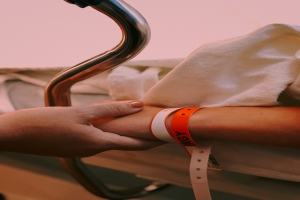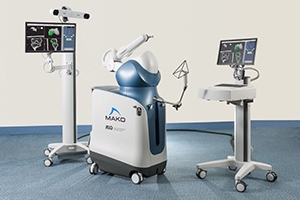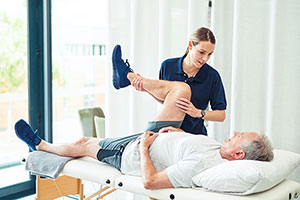Your hip is a ball-and-socket joint comprising the femoral head, the topmost part of your thighbone (the ball), and the acetabulum, the socket part of the hip joint. A soft tissue called the labrum covers the acetabulum and allows the femoral head to move smoothly within it.
When the labrum tears, your hip joint loses lubrication, making it difficult or even painful for you to move. You may also experience stiffness in the hip, pain that increases with prolonged sitting, or deep pain in the front of your hip. Many factors can cause this condition to develop, such as structural ailments, hip injuries, and degenerative health conditions.
While not all hip labral tears require surgery, doctors may recommend such a procedure if more conservative treatment options fail to bring you labral hip pain relief.
To help give you a holistic overview of hip labral tear recovery, the sections below will provide you with some insight into the labral repair protocol and answer frequently asked questions about labral tear treatment.
How Long Does Hip Labral Tear Recovery Take?
After a hip labral tear surgery, most patients spend four months in one-on-one physical therapy sessions and can then ease back into their everyday activities subsequently. However, it can take them up to nine months to get back to their hundred percent.
But remember that every patient has a unique injury, so one hip labral tear condition may take longer to heal than the other. It works on a case-to-case basis, and the most important thing is to listen to your body and cooperate with your physical therapist (PT) to create the best post-op treatment plan for you.
Now that we have covered the recovery time, here’s a general hip labral tear recovery timeline to help set your expectations about the whole treatment process.
Hip Labral Tear Recovery Timeline - An Overview
Physical therapy plays a crucial role in your recovery and rehabilitation after a hip labral tear surgery. In most cases, sessions begin within the first few days after your procedure and last for 12 weeks. Throughout this time, your physical therapist will guide you through exercises that will not only speed up your recovery time but also help you regain your strength and mobility healthily.
0-4 WEEKS POST-SURGERY
Within the first week following your surgery, your physical therapist will introduce you to a treatment plan to reduce pain and swelling. Of course, this will depend on your surgeon’s advice or labral repair protocol.
Once you’re given the go-signal to start rehabilitation, your physical therapist will ease you into different techniques like manipulative therapies to alleviate pain and passive range of motion exercises (PROM) to help increase blood circulation and decrease swelling. Your therapist will also educate you on how to return to your daily activities safely and gradually.
4-8 WEEKS POST-SURGERY
You should be moving comfortably and gaining more mobility by this time, so your PT will introduce more exercises to continue improving your stability, strength and range of motion. You can expect activities such as walking short distances and using the upright bike with resistance. You may also be eased into activities like swimming, elliptical training and other core and leg exercises around the eighth week.
8-12 WEEKS POST-SURGERY
Within two to three months following your hip labral tear surgery, your PT may introduce weight-bearing activities. You’ll continue walking and using the upright bike, but this time you’ll perform additional exercises such as bodyweight squats, step-ups and step-downs and balance training. These are designed to help you build strength and endurance further while improving your stability.
12-16 WEEKS POST-SURGERY
If your rehabilitation program has been progressing well for the past four months, you’ll likely start running, jumping and performing other impact exercises. Your PT will also guide you through dynamic drills to work on your agility and balance. Some activities you can expect by this time include loaded and unloaded jumping, single leg balance, agility drills, jumping, jogging and running.
At this point in your recovery, make sure to carry on with the exercises recommended by your therapist even at home. Diligently following your program will help you preserve your progress and expedite your complete recovery.
4+ MONTHS POST-SURGERY
After four months following your procedure, you likely won’t need one-on-one physical therapy sessions anymore. However, you must continue with the home exercise program provided by your therapist to keep the strength and mobility you’ve worked hard to regain in the past months. It’s also recommended that you consult with your PT if you have any worries or questions about returning to certain activities.
Finally, remember to be patient with your body since complete recovery could take six to nine months. As long as you remain diligent with your exercise program, you’ll surely see positive results sooner than later.
Get the Best Possible Outcome at the American Hip Institute
It’s natural to feel discomfort in your hip, buttocks or lower back after your operation. You also won’t be able to do the activities you used to do and enjoy right away. The good news is that there are medications available to alleviate the pain or reduce the swelling. Aside from that, a personalized physical rehabilitation program can help you rebuild your strength, stability and mobility safely, allowing you to return to your routine.
But to gain long-lasting labral hip pain relief and get the best possible outcome for your hip labral tear recovery, consider seeking treatment at renowned experts in hip surgeries like The American Hip Institute. As a leader in advanced treatment of the hip, we offer cutting-edge techniques in hip arthroscopy and robotic hip replacement to restore you to your top-level performance.
For more information about our minimally invasive labral tear treatment options, contact us today or schedule a virtual appointment.




